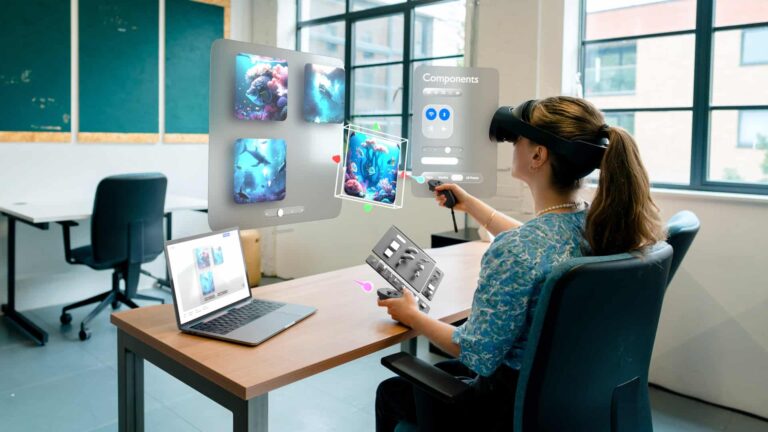
ShapesXR is a VR design and collaboration platform. But what makes it different is that users, as Meta avatars, collaborate on VR design while inside VR. How Meta.
Launched in November 2021, ShapesXR enables up to thirty participants, developers, and, importantly, non-developers, to share a spatial VR environment where they can work together. Users can create their own content using ShapesXR templates, or start from scratch, building and uploading their own 3D models in .obj format. Designers can introduce and manipulate simple shapes: scale them, change color and materials, research user flows, and review prototypes as 3D storyboards. The resulting design can then be imported into Unity with textures and properties intact for further refinement.
“The only way to really grapple with spatial design concepts such as UI positioning in 3D, contextual anchoring, and managing user attention, is to use apps like ShapesXR,” said Daniel Robbins, Product Designer, Gen AI/3D/AR/VR at Adobe. “You can very quickly mock up a project and get an early understanding of how things look and feel spatially”.
Mark Zuckerberg recently singled out ShapesXR as an example of VR’s unrivaled capacity for creativity and collaboration. In an interview last year, Anand Dass, Director of VR/AR Content at Meta, called ShapesXR “One of the most promising VR applications I have come across” and the “future of collaborative design.” ShapesXR has been downloaded more than 350,000 times on the Meta Quest app store, has been licensed to 70 educational institutions and scores of enterprises. More than 300,000 projects have already been created using the app.
Nanea Reeves, Founder and CEO of TRIPP, the popular guided VR meditation app, says she’s able to brainstorm alone some next-level concepts for TRIPP and then invite her team into VR to walk through the ideas and get their contribution as well.
“The upfront thinking of product ideation in spatial before beginning the product design and development in Unity is a productivity game changer for our team,” said Reeves in an email.
“VR has such huge potential to transform how we all collaborate on projects and design new products,” said Inga Petryaevskaya, CEO and Founder at ShapesXR, “One of the main barriers to entry is the level of technical skill required to get started. ShapesXR has been built to remove these hurdles – it’s as easy to learn as PowerPoint. This truly democratizes 3D content creation and enables anyone to become a VR, AR, and mixed reality storyteller.”
All the above took a step forward last month when ShapesXR secured an $8.6 million seed round led by Supernode Global. The new funding will enable ShapesXR to expand onto new platforms like Apple’s new Vision Pro and the Magic Leap 2. The company charges enterprise users but not individuals. Free accounts allow for a limited number of projects and collaborators, but paid users can have up to 30 people in the simulation at the same time. The company says its platform has been adopted by hundreds of VR/AR studios and Fortune 500 companies, such as Logitech, Accenture, ByteDance, and Meta.
Following Supernode Global are Triptyq VC, Boost VC, Hartmann Capital, Geek Ventures, the WXR Fund, Leta Capital, StratMinds VC, the Venture Reality Fund, Ludus Ventures, and HTC Vive. This prominent list should help ShapesXR to continue reshaping the way XR experiences are designed and developed.
 Charlie Fink is the author of the AR-enabled books “Metaverse,” (2017) and “Convergence” (2019). In the early 90s, Fink was EVP & COO of VR pioneer Virtual World Entertainment. He teaches at Chapman University in Orange, CA.
Charlie Fink is the author of the AR-enabled books “Metaverse,” (2017) and “Convergence” (2019). In the early 90s, Fink was EVP & COO of VR pioneer Virtual World Entertainment. He teaches at Chapman University in Orange, CA.






